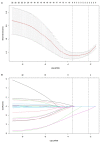Predictors of Failed Intrauterine Balloon Tamponade in the Management of Severe Postpartum Hemorrhage
- PMID: 34336876
- PMCID: PMC8319466
- DOI: 10.3389/fmed.2021.656422
Predictors of Failed Intrauterine Balloon Tamponade in the Management of Severe Postpartum Hemorrhage
Abstract
To identify the factors predicting intrauterine balloon tamponade (IUBT) failure for severe postpartum hemorrhage (PPH) after delivery, we conducted a retrospective cohort study of women who underwent IUBT for severe PPH after delivery from October 1, 2016 until September 30, 2017. The failure of IUBT was defined as the need of additional surgical procedures or uterine embolization. A total of 99,650 deliveries occurred during the study period. Among the patients, 106 cases of severe PPH were managed with IUBT, and the global success rate was 70.8% (75/106). Least absolute shrinkage and selection operator (LASSO) regression was performed to select the potential risk factors predicting IUBT failure. The associated risk factors-obesity, multiple gestation, cesarean delivery, estimated blood loss (EBL), and placenta accreta spectrum (PAS)-were included in multivariate logistic models. Ultimately, these models identified multiple gestation, EBL, and PAS as independent risk factors for IUBT failure. In conclusion, IUBT is an effective method for severe PPH. The presence of factors affecting IUBT failure should be recognized early, and other modalities of management should be anticipated.
Keywords: hysterectomy; intrauterine balloon tamponade; multiple gestation; placenta accreta spectrum; postpartum hemorrhage.
Copyright © 2021 Liu, Gao, Liu, Wang, He, Sun, Liu and Liao.
Conflict of interest statement
The authors declare that the research was conducted in the absence of any commercial or financial relationships that could be construed as a potential conflict of interest.
Figures


Similar articles
-
Predictors of failed intrauterine balloon tamponade for persistent postpartum hemorrhage after vaginal delivery.PLoS One. 2018 Oct 26;13(10):e0206663. doi: 10.1371/journal.pone.0206663. eCollection 2018. PLoS One. 2018. PMID: 30365539 Free PMC article.
-
Prognostic factors for the use of intrauterine balloon tamponade in the management of severe postpartum hemorrhage.Int J Gynaecol Obstet. 2018 Jul;142(1):48-53. doi: 10.1002/ijgo.12498. Epub 2018 Apr 17. Int J Gynaecol Obstet. 2018. PMID: 29603742
-
Intrauterine balloon tamponade for management of severe postpartum haemorrhage in a perinatal network: a prospective cohort study.BJOG. 2017 Jul;124(8):1255-1262. doi: 10.1111/1471-0528.14382. Epub 2016 Oct 25. BJOG. 2017. PMID: 27781401
-
Intrauterine balloon tamponade in the management of severe postpartum haemorrhage after vaginal delivery: Is the failure early predictable?Eur J Obstet Gynecol Reprod Biol. 2021 Mar;258:317-323. doi: 10.1016/j.ejogrb.2021.01.030. Epub 2021 Jan 20. Eur J Obstet Gynecol Reprod Biol. 2021. PMID: 33498006 Review.
-
Uterine balloon tamponade for the treatment of postpartum hemorrhage: a systematic review and meta-analysis.Am J Obstet Gynecol. 2020 Apr;222(4):293.e1-293.e52. doi: 10.1016/j.ajog.2019.11.1287. Epub 2020 Jan 6. Am J Obstet Gynecol. 2020. PMID: 31917139
Cited by
-
Severe postpartum hemorrhage and the risk of adverse maternal outcome: A comparative analysis of two population-based studies in France and the Netherlands.Prev Med Rep. 2024 Feb 23;40:102665. doi: 10.1016/j.pmedr.2024.102665. eCollection 2024 Apr. Prev Med Rep. 2024. PMID: 38435415 Free PMC article.
-
Performance of Bakri balloon tamponade in controlling postpartum hemorrhage.Am J Transl Res. 2023 Mar 15;15(3):2268-2279. eCollection 2023. Am J Transl Res. 2023. PMID: 37056856 Free PMC article.
-
Introduction of the Ellavi uterine balloon tamponade into the Kenyan and Ghanaian maternal healthcare package for improved postpartum haemorrhage management: an implementation research study.BMJ Open. 2023 Feb 3;13(2):e066907. doi: 10.1136/bmjopen-2022-066907. BMJ Open. 2023. PMID: 36737079 Free PMC article.
-
Bakri Balloon for Treatment of Postpartum Hemorrhage: A Real-World 2016-2020 Study in 279 Women from a Single Center.Med Sci Monit. 2023 Mar 1;29:e938823. doi: 10.12659/MSM.938823. Med Sci Monit. 2023. PMID: 36855288 Free PMC article.
-
Differential Effects of Intrauterine Balloon Tamponade Indications on Postpartum Hemorrhage Outcomes.Front Med (Lausanne). 2022 Apr 1;9:851174. doi: 10.3389/fmed.2022.851174. eCollection 2022. Front Med (Lausanne). 2022. PMID: 35433757 Free PMC article.
References
LinkOut - more resources
Full Text Sources

